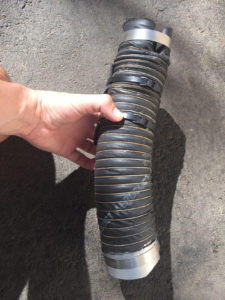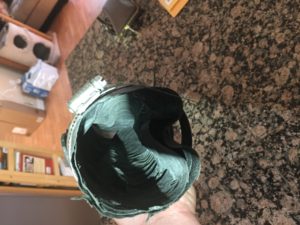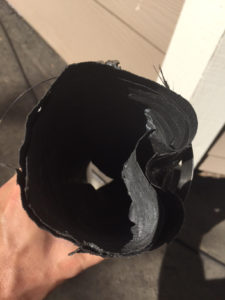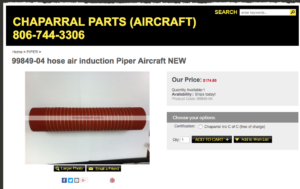Podcast: Play in new window | Download
Scroll down to see a video about scat hose installation.
Recently, I got an email from Jeremy Zawodny, and he told me a story about his Glastar airplane, which is powered by a Lycoming O-320 engine. He experienced a partial power loss soon after takeoff, and when he pulled the carb heat, the power was restored. Listen to today’s episode to hear the rest of the story.
Here are some pictures of Jeremy’s induction airhose:
Well done Jeremy, in replacing that worn hose! And thanks for letting us share your story!
There was an SAIB (Special Airworthiness Information Bulletin,) that was issued awhile back that talked about air hoses on Piper airplanes. Here’s a link for that SAIB… it’s worth taking a look at and checking your air hoses, whether you have a Piper, or some other type of aircraft.
It seems there is a mistake in the bulletin about the part number for the air duct they talk about. Here’s a picture of one part number air duct that is used for some Pipers:
Remember, there are 4 different types of air hoses (ducts) that we talked about in this episode:
- Scat – Single layer red/orange color high temp hose with thread on the outside and steel wire on the inside.
- Sceet – Same as Scat, except double layer fabric, with the steel wire between the layers.
- Cat – Single layer black lower temp hose with thread on the outside and steel wire on the inside.
- Ceet – Same as Cat, except double layer fabric, with the steel wire between the layers.
If you own an airplane, go check your air hoses in the engine compartment, and make sure they are in good condition and none are about to collapse.
Finally, here’s a YouTube video I just posted, about how to install the most common type of scat hoses I’ve seen in airplane engine compartments.







Thanks for the episode, Dean.
You’re right about something I forgot to mention–there was NO initial decrease in RPM when I applied carb heat in flight. That should have been another clue that it was not ice, since I know that applying carb heat usually results in an RPM drop i the 80-100 rpm range.
Jeremy
Thanks Jeremy. That’s really good additional information.
Hey Dean,
Catching up on old episodes, and enjoying every one!
While looking on Aircraft Spruce & Specialty to find out more about the SCAT, SCEET, CAT and CEET hoses, I noted the following under their Aeroduct SCEET Ducting listing (https://www.aircraftspruce.com/catalog/appages/thermoid-ad-sceet.php):
“Not recommended for handling liquids or highly abrasive materials, or for negative pressure applications. ”
[Note that this warning is not present on the other brands of SCEET that they sell.]
This makes sense as any delamination will likely cause a collapse with negative pressure. The induction system is under negative pressure, so this is an important consideration. Production aircraft with approved parts probably will not use SCEET, but this is an important consideration for E-AB aircraft!!!
Thought this is important to pass along.
Thanks Steven! That’s a very good point… thanks for sharing it!